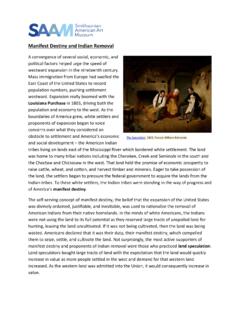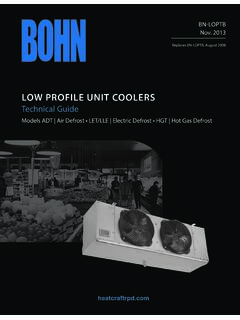Transcription of BASIC HYDRONIC SYSTEM DESIGN - ASHRAE
1 HYDRONIC Systems BASIC HYDRONIC SYSTEM . DESIGN . Terminal Units FCU FCU FCU FCU FCU FCU. Fan Coils, Chilled Beams, Finned Tube, Radiant, etc. Distribution Piping AS-1. P-1. Decoupler Primary Pumps ET-1. P-B-1. Closely Spaced Tees P-1 & P-2. P-2. B-1. P-B-2. Expansion Generation Equipment Tank Air / Dirt B-2. Secondary Pumps Boilers, Chillers, Cooling Separator P-B-1 & P-B-2 Towers, WWHPs, etc. 1. REFERRING TO PUMPS. FCU FCU FCU FCU FCU FCU. FCU FCU FCU FCU FCU FCU. AS-1. AS-2. P-1. P-3. P-B-1. ET-1 P-CH-1. ET-2. P-2. P-4. B-1 CH-1. Primary P-B-2. Secondary P-CH-2. Pumps B-2. Pumps CH-2. Secondary Primary Pumps Pumps HEATING COOLING. AIR/DIRT SEPARATORS. Air Vents at High Points Reduce Fluid Velocity Change Fluid Direction Reduce Pressure (Tangential). Coalescence (Microbubble). 2. EXPANSION TANKS. Control pressure, control problems Expansion tanks control thermal expansion and contraction of SYSTEM fluid z Establish the point of no pressure change.
2 Full Acceptance Partial Acceptance Partial Acceptance Bladder type Bladder type Diaphragm type CENTRIFUGAL PUMP. COMPONENTS. Bearing Frame Casing / Volute Assembly Discharge Motor Suction Drain Pan Coupler w/Guard Base 3. CENTRIFUGAL PUMP. COMPONENTS. Bearing Frame Woods Dura-Flex Impeller Assembly Coupler Motor Mechanical Pump Shaft Motor Shaft Seal COUPLER. Woods Dura-Flex Coupler 4. BEARING ASSEMBLY. Bearing Frame Assembly MECHANICAL SEAL. Cover Impeller StationarySeat Pump Shaft Slip-on Shaft Sleeve Rotating Element John Crane (Type 21) mechanical seal 5. END SUCTION PUMPS. End Suction Pumps z Most Popular Style z Suction / Discharge at 90 . z Split coupled allows servicing without disturbing pipe connections Base Mounted, Split Coupled Foot Mounted, Close Coupled IN-LINE PUMPS. In-Line Pumps z Suction / Discharge are In-Line z Differentiated by shaft orientation z Pipe supported, not fixed to structure Horizontal In-Line Vertical In-Line 6.
3 SPLIT CASE PUMPS. Split Case z Two sets of bearings to support shaft z Allows Access to both seals without moving motor or disturbing piping z Up to 1,500 HP. Horizontal Split Case Vertical Split Case VERTICAL TURBINES. Vertical Lineshaft Turbine Designed to Lift Liquid from Sump / Tank Motor and Impeller are separated Impellers Push better than Pull . Cooling Tower Sumps 7. NEW SMART PUMPS. Speed varies without sensors High Efficiency ECM. z Electronically Commutated Motor z DC Brushless Motor Integral VFD. Sophisticated Electronics Residential to Light Commercial TYPICAL. CAPACITIES. TYPE GPM HD (FT.) HP RPM. HORIZ. IN-LINE 20 - 375 10 - 75 -3 1760, 3500 . END SUCTION 40 4,000 10 - 400 - 200 1160, 1760, 3500 . VERTICAL IN-LINE 40 12,000 10 - 400 - 600 1160, 1760, 3500 . SPLIT CASE 100 18,000 20 - 500 3 1,500 1160, 1760, 3500 . VERTICAL TURBINE 20 6,000 10 - 150 - 150 1160, 1760. 8. CENTRIFUGAL PUMP. FUNCTION. Pumps create Differential Pressure ( P).
4 Water Flows From Higher Pressure to Lower Pressure The P Induces Flow Against SYSTEM Resistance In an Open SYSTEM the P also Induces Lift Against Atmospheric Pressure and Gravity CENTRIFUGAL PUMP. BASIC OPERATION. Impeller spin accelerates the liquid radially Liquid forced to the outside of the impeller Cutwater diverts liquid out through the discharge Impeller eye is point of lowest pressure Discharge Suction Impeller Cutwater 9. CENTRIFUGAL PUMPS. AFFINITY LAWS. The Pump Affinity Laws are a series of relationships relating: Flow (GPM). Head (HEAD). Horsepower (BHP). RPM Speed (RPM). Impeller Dia. (DIA). Allow designers to estimate pump performance under different conditions AFFINITY LAW #1. GPM varies with RPM. Pump speeds up, flow increases Pump slows down, flow decreases GPM varies with DIA. Large diameter impellers move more flow Small diameter impellers move less flow 10. AFFINITY LAW #1. 1760 RPM. 60 Hz 1170 RPM.
5 40 Hz 580 RPM. 20 Hz AFFINITY LAW #2. HEAD varies as the square of the RPM. Pump speeds up, head increases exponentially Pump slows down, head decreases exponentially 11. AFFINITY LAW #2. AFFINITY LAW #3. BHP* varies as a cube of RPM. Pump speeds up, BHP increases by cube Pump slows down, BHP decreases by cube BHP = Brake Horsepower is the actual power required to rotate the pump shaft. It is the portion of the motor HP that does the work. 12. AFFINITY LAWS. Reducing Speed by Half: Change in RPM Change in Change in Change in BHP. (or DIA) GPM HEAD. x 1/2 x 1/2 x 1/4 x 1/8. Doubling Speed: Change in RPM Change in Change in Change in BHP. (or DIA) GPM HEAD. x2 x2 x4 x8. AFFINITY LAWS. How much HP is required to operate a 100 HP, 1760 RPM. motor at half speed? 13. AFFINITY LAWS. RPM GPM HEAD BHP. 100% 100% 100% 100%. 90% 90% 81% 72%. 75% 75% 56% 42%. 50% 50% 25% 25% 25% 6% Getting Into the Flow . the application of VFDs to constant speed pumps is now the fastest growing segment of the commercial pumping industry, a trend that improves ( SYSTEM ).
6 Performance and efficiency . 14. WHY VFDs on PUMPS. Soft Start Same cost as a motor starter Gentler on motors Reduces inrush current Balancing without multi-purpose valve Significant energy saving opportunity Variable Flow Flow varies according to demand Ultimate energy savings Pump Curves 15. Pump Curves PUMP CAN ONLY OPERATE ON ITS CURVE. 13 . 12 . IMPELLER CURVES. 200 11 . 10 . HEAD. (FT). 100. 10 0 20 0 30 0 40 0 50 0 60 0 70 0. FLOW (GPM). SYSTEM Curve 200. FLOW = HEAD . ( Y = X ). HEAD. (FT). 100. SYSTEM CURVE. (PARABOLA). 10 0 20 0 30 0 40 0 50 0 60 0 70 0. FLOW (GPM). 16. Horsepower Curves PUMP OPERATES WHERE SYSTEM AND IMPELLER CURVES INTERSECT. IMPELLER CURVE. 10 15 20. HP CURVES. 200. OPERATING POINT. HEAD. (FT). 100. SYSTEM CURVE. (PARABOLA). 10 0 20 0 30 0 40 0 50 0 60 0 70 0. FLOW (GPM). Parallel Pumping Correct Selection GPM IS ADDITIVE, HEAD REMAINS THE SAME. SYSTEM . CURVE. 200. 2 PUMPS ON. OPERATING POINT.
7 1 PUMP ON. 100. OPERATING POINT. IMPELLER CURVES. STATIC P1 or P2 P1 + P2. HEAD. 10 0 20 0 30 0 40 0 50 0 60 0. 17. Parallel Pumping Incorrect Selection GPM IS ADDITIVE, HEAD REMAINS THE SAME. SYSTEM . CURVE. 200. 2 PUMPS ON. OPERATING POINT. 100. P1 or P2 P1 + P2. IMPELLER CURVES. One pump running does not intersect with SYSTEM curve STATIC Result = No Flow HEAD. 10 0 20 0 30 0 40 0 50 0 60 0. HYDRONIC Piping Systems Direct Return SYSTEM Reverse Return SYSTEM Primary-Secondary Pumping SYSTEM Injection Pumping SYSTEM Series Pump SYSTEM Zone Pumping SYSTEM Single Pipe SYSTEM 18. Direct Return (First In/First Out). Advantages Shorter Pipe Runs Lower first cost Lower pump head Disadvantages z Poor Comfort Does not insure adequate flow to all terminal units z Not Self Balancing Balance valves and balancing required Reverse Return (First In/Last Out). Advantages Improved Comfort Greater assurance of adequate flow to all terminal units all times Self Balancing Disadvantages Longer Pipe Runs Higher first cost Higher pump head 19.
8 Primary-Secondary Advantages Improved Comfort Reduced complexity of balancing Lower Operating Cost Reduced pump horsepower by separating zones with different loads, operating temperatures, or pipe length Disadvantages Increased Number of Pumps and First Cost DECOUPLING. Distance Between Tees as Short as Possible (Tee to Tee). Pressure Drop Between Tees Will Determine Flow in Secondary Circuit when Secondary Pump is Off WATER ALWAYS FOLLOWS PATH OF LEAST RESISTANCE. 20. Single Pipe Advantages z Maximum Comfort Insures adequate flow to all terminal units at all times z Self balancing z Lower First Cost Eliminate control valves, balance valves, balancing, pipe and fittings Disadvantages z Requires accounting for temperature cascade to provide adequate capacity of terminal units. Injection Pumping Advantages z Lower Operating Cost Operate secondary systems at optimum operating temperatures z Lower First Cost Use one primary boiler SYSTEM for multiple secondary systems requiring different operating temperatures.
9 Disadvantages z Increased Number of Pumps and First Cost 21. Injection Pumping . Another Look! Zone Loop Injection Building Loop Series Pumping SYSTEM Advantages 30000 BTU/H. GPM. 100 F. GPM. 7 FT. GPM. 12 FT. z Lower Operating IHL-1. 110 F P-2 P-1. Cost 40000 BTU/H. GPM. 100 F. GPM. 7 FT. Reduced pump IHL-2. 110 F P-3. 140 F 180 F. 120000 BTU/H. horsepower by 50000 BTU/H. GPM. 160 F GPM. GPM. separating zones 180 F. 7 FT. B-1. P-4. with different loads IHL-3. Disadvantages z Increased Number of Pumps and First Cost z Operation of Pumps Affects Flow in Other Circuits z Pumps are not decoupled z Increased complexity of balancing 22. Zone Pumping Advantages 30000 BTU/H. GPM. 100 F. GPM. 12 FT. z Lower Operating IHL-1. 110 F P-1. Cost 40000 BTU/H. GPM. 100 F. GPM. 12 FT. Reduced pump IHL-2. 110 F P-2. 140 F 180 F. horsepower by 50000 BTU/H. 160 F. 120000 BTU/H. GPM. GPM. separating zones GPM. 12 FT. 180 F B-1. with different loads IHL-3.
10 P-3. Disadvantages z Increased Number of Pumps and First Cost z Operation of Pumps Affects Flow in Other Circuits z Increased complexity of balancing Single Pipe Single Pipe SYSTEM Independent Decoupled Secondary Circuits for all Terminal Units Use Circulators Instead of Valves No Control Valves z Control Zone Temperature with Circulators Only z On/Off or Variable Speed No Balance Valves z Self Balancing 23. Next Generation Green Piping Systems Integrated Piping Systems z Heating / Cooling / Fire Protection (Condenser Water). Trade Names Tri Water z Cooling / Fire Protection (Chilled Water). Trade Names Total Comfort Solution, Ultimate Comfort Systems z Cooling / Domestic Cold Water (Chilled Water). Trade Names Total Comfort Solution z Heating / Domestic Hot Water (Hot Water). Trade Names Aqua Therm, Hydro Heat, Total Comfort Solution, Ultimate Comfort Systems z Less Materials Next Generation Green Piping Systems Single Pipe LoadMatch.






